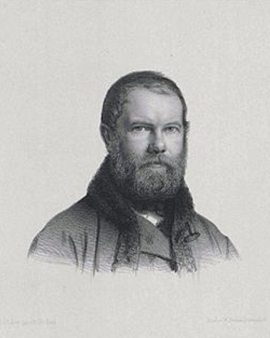


The story of Johann Wilhelm Schirmer, born in Jülich on September 7, 1807 and died in Karlsruhe on September 11, 1863, reads like a captivating narrative of an artistic journey. His footprints in the realm of art are deep and irrevocable. Each art print made of his works promises to immerse the viewer in the depths of this journey.
In the streets of Jülich, marked by the scars of his childhood and the siege of 1814, Schirmer's passion for art began. His beginnings were humble, but his thirst for knowledge led him to the Düsseldorf Academy of Art. Here he found not only education, but also inspiration. Under the watchful eyes of Wilhelm Schadow and Heinrich Kolbe, Schirmer shaped himself. His work "German Jungle" became a topic of conversation, and the gold medal he received at the Salon de Paris in 1838 solidified his place among the stars.
His vivid imagination, influenced by travels throughout Europe, resulted in a play of color and tone in his works that touched the soul. With each stroke of his brushes, Schirmer revealed not only the outer landscape, but also the inner landscape of the human spirit. His stay in Rome between 1839 and 1840 broadened his view of art. He was inspired by the eternal city and took many of his works in a more stylized and idealized direction, often using biblical motifs that emphasized his understanding of nature as divine revelation.
But Schirmer's contribution was not limited to his own creations. As a professor and eventually as the first director of the newly founded Karlsruhe Art School, he influenced generations of artists. Names like Hans Thoma and Anton Alexander von Werner are just a few of the many who flourished under his tutelage. His printmaking works, though lesser known, were of great importance to the emerging artist and reflect his diversity and depth.
Johann Wilhelm Schirmer left a legacy not only through his works, but also through his influence. His importance to 19th century German landscape painting remains undeniable, and streets named after him, as well as numerous honors, confirm this. For those fortunate enough to own an art print of his work, it is a window into his soul and a testament to his brilliance.

The story of Johann Wilhelm Schirmer, born in Jülich on September 7, 1807 and died in Karlsruhe on September 11, 1863, reads like a captivating narrative of an artistic journey. His footprints in the realm of art are deep and irrevocable. Each art print made of his works promises to immerse the viewer in the depths of this journey.
In the streets of Jülich, marked by the scars of his childhood and the siege of 1814, Schirmer's passion for art began. His beginnings were humble, but his thirst for knowledge led him to the Düsseldorf Academy of Art. Here he found not only education, but also inspiration. Under the watchful eyes of Wilhelm Schadow and Heinrich Kolbe, Schirmer shaped himself. His work "German Jungle" became a topic of conversation, and the gold medal he received at the Salon de Paris in 1838 solidified his place among the stars.
His vivid imagination, influenced by travels throughout Europe, resulted in a play of color and tone in his works that touched the soul. With each stroke of his brushes, Schirmer revealed not only the outer landscape, but also the inner landscape of the human spirit. His stay in Rome between 1839 and 1840 broadened his view of art. He was inspired by the eternal city and took many of his works in a more stylized and idealized direction, often using biblical motifs that emphasized his understanding of nature as divine revelation.
But Schirmer's contribution was not limited to his own creations. As a professor and eventually as the first director of the newly founded Karlsruhe Art School, he influenced generations of artists. Names like Hans Thoma and Anton Alexander von Werner are just a few of the many who flourished under his tutelage. His printmaking works, though lesser known, were of great importance to the emerging artist and reflect his diversity and depth.
Johann Wilhelm Schirmer left a legacy not only through his works, but also through his influence. His importance to 19th century German landscape painting remains undeniable, and streets named after him, as well as numerous honors, confirm this. For those fortunate enough to own an art print of his work, it is a window into his soul and a testament to his brilliance.
Page 1 / 1






